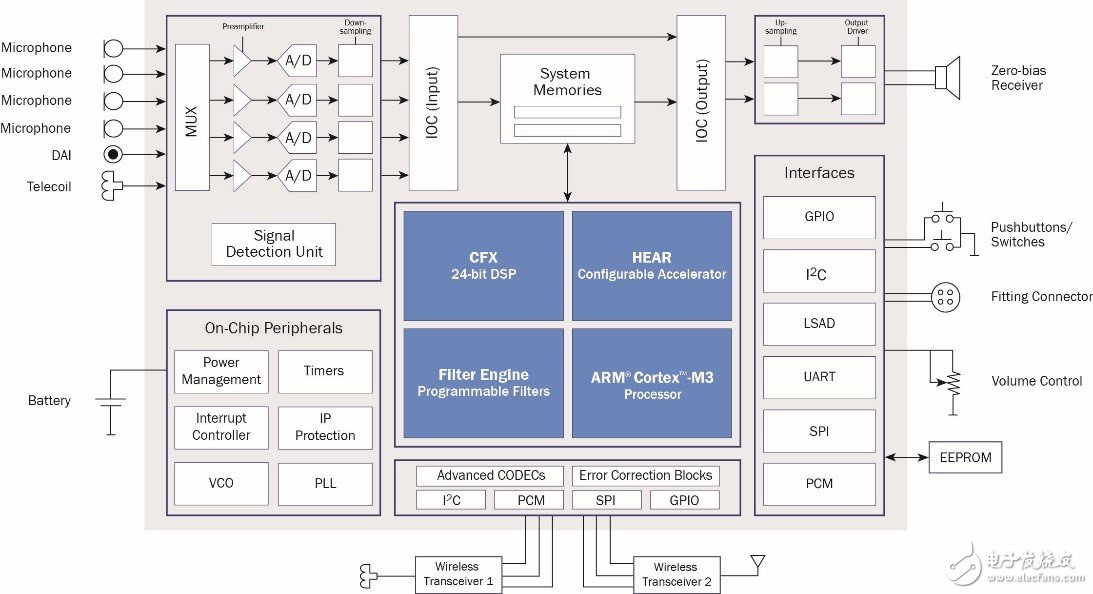Application of advanced DSP technology in hearing aids
Few applications face more technical limitations than modern hearing aids. Here, the need to increase performance levels and reduce power consumption in smaller designs is greater than consumer electronics.
This pressure is magnified by the fact that the hearing aid industry is currently growing 4-6% per year (according to some well-known market research companies), driven by the aging of China and India and new market developments. Therefore, it is necessary to meet a wider range of patients with improved functionality.
By integrating more sophisticated digital signal processing (DSP) semiconductor solutions, manufacturers will be able to meet these needs for hearing aid users. The various design considerations affecting DSP technology and their application in today's hearing aids are detailed below.
In simple terms, the hearing aid works as follows. The sound waves are received by the microphone and converted into an analog electrical signal. An analog-to-digital converter picks up the analog signal and converts it into a digital signal. Then, it is processed and adjusted by the DSP algorithm. The digital signal is then reconverted to analog form, passed to the receiver, and converted to sound waves heard by the hearing aid user. In order to minimize the visual impact of these devices and improve the comfort of the wearer, a more discrete new model was introduced. Commonly used behind-the-ear (BTE) devices are now being replaced by deeper hearing aids located in the ear canal, such as deep ear canal (CIC) and invisible ear canal (IIC) devices, or miniature earmuff devices (also known as miniature behind-the-ear or OTE) ). The "hear but not see" trend of hearing aids requires a large number of systems to be miniaturized into integrated circuits that power devices.
Customized requirements
Original equipment manufacturers (OEMs) are exploring IC solutions that enable the hearing aid's own unique data signal processing algorithms. This will support a more energy-efficient "platform" strategy in place, with different hearing aid models created from the same-core DSP. For example, mild hearing loss can be addressed by a specific set of algorithms, while high-power devices that address severe hearing impairment can use the same platform but differ from additional gain or function and performance.
Wireless interconnection with portable electronic devices
There has been considerable interest in using wireless technology to enable audio signal transmission between hearing aids and electronic devices such as smartphones. Through the 2.4 GHz band (based on Bluetooth and ZigBee wireless standards), wireless interworking allows audio-visual users to experience audio directly from electronic devices. For example, users can stream music from a handheld device or use their hearing aids as a headset to make a call. Wireless interworking also enhances the interaction between users and devices. With a smartphone, hearing aid users can easily adjust and customize parameters and settings (such as volume control) without the need for cumbersome relay accessories. Because wireless technology does not have clear standards, engineers must be able to quickly adapt to emerging standards such as Bluetooth low energy.
DSP architecture selection
There are many different types of DSP architectures available for modern semiconductors. Since the architecture will have a considerable impact on the overall energy efficiency of the hearing aid design, the OEM engineering team should ensure that they carefully consider the available options and finally make a decision to choose one.
Closed architecture
A closed, fixed-function DSP is directly hardwired into the architecture to optimize system power and size. But at the expense of system flexibility. Although some small parameters are still adjustable, the basic functionality of the IC cannot be changed without a large reset operation - which is expensive and time consuming.
2. Open programmable architecture
The open programmable architecture provides OEMs with improved design flexibility because DSP algorithms are relatively easy to modify. However, this flexibility is accommodated in a larger system that does not meet the stringent power and size requirements of modern hearing aids.
3. Semi-programmable and application-specific, open programmable architecture
Alternative architectures that combine the benefits of closed and open programmable are now emerging. Semi-Programmable Architecture The basic DSP functions are hard-access logic blocks and additional programmable DSP elements, and additional capabilities can be implemented in software. While this provides some flexibility, the semi-programmable architecture still has a much larger power budget than a closed architecture. A specific application, open programmable architecture proposes another approach. Here, the DSP architecture is designed and optimized in conjunction with an in-depth understanding of the application requirements to handle the specific signal processing requirements of a particular application. It has software programmability in an open programmable architecture and power efficiency comparable to that of a closed architecture, and the design layout is well implemented and utilizes the appropriate semiconductor geometry. This architecture advances the platform solutions that OEMs now need.
ON Semiconductor's Ezairo 7100 is a compact, extremely sophisticated system-on-chip (SoC) solution for the next generation of hearing aid deployments. It combines an analog front end, an ARM Cortex-M3 processor, and a 24-bit quad-core DSP (application-specific, open programmable architecture) to a single semiconductor chip. The implementation of a closed and open programmable hybrid architecture means that the IC consumes less than 0.7 mA at maximum clock speed of 10.24 MHz. This reduces system power consumption while still giving engineers the necessary design flexibility (algorithm adjustable) to create a feature-rich hearing aid design that stands out from the competition.

In short, the technology of the hearing aid industry is constantly changing – taking advantage of rapidly evolving innovations and targeting emerging markets. Strong competition and faster market demand for the market have led to shorter product life cycles and greater differentiation. Using ON Semiconductor's programmable or application-specific DSP technology, engineers will create smaller, feature-rich hearing aids that increase user comfort and satisfaction.
Car Screen Protector,Car Center Console Screen Protector,Car Touchscreen Screen Protector
Shenzhen Jianjiantong Technology Co., Ltd. , https://www.jjtbackskin.com